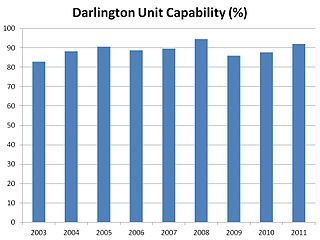
Pickering Nuclear Generating Station is a Canadian nuclear power station located on the north shore of Lake Ontario in Pickering, Ontario. It is one of the oldest nuclear power stations in the world and Canada's third-largest, producing about 15% of Ontario's power and employing 3,000 workers.

Darlington Nuclear Generating Station is a Canadian nuclear power station located on the north shore of Lake Ontario in Clarington, Ontario. It is a large nuclear facility comprising four CANDU nuclear reactors with a total output of 3,512 MWe when all units are online. It is Canada's second-largest NPS and provides about 20 percent of Ontario's electricity needs, enough to serve a city of two million people. It is named for the Township of Darlington, the name of the municipality in which it is located at the time of its planning.

The Portlands Energy Centre is a 550-megawatt natural gas electrical generating station in Toronto, Ontario. It is located in the Port Lands area of the Toronto waterfront at 470 Unwin Avenue, adjacent to the site of the decommissioned Hearn Generating Station.

The Lakeview Generating Station was an Ontario Power Generation coal-burning station located in Lakeview, a community just east of Port Credit, in Mississauga, Ontario, Canada. The former station, constructed in 1958-1962, was located just east of Lakeshore Road and Cawthra Road. The four stacks of the station were known as the Four Sisters; the eight boilers of the generating plant all 'twinned' their emissions into common stacks. The station was a landmark for years and was shut down in April, 2005, after 43 years of service. The four stacks, which could be seen from as far away as Burlington to the west and downtown Toronto to the east, were demolished on June 12, 2006. The rest of the building was demolished on June 28, 2007.

The Nanticoke Generating Station was a coal-fired power station in Nanticoke, Ontario in operation from 1972 to 2013. It was the largest coal power station in North America and, at full capacity, it could provide 3,964 MW of power into the southern Ontario power grid from its base in Nanticoke, Ontario, Canada, and provided as much as 15% of Ontario's electricity.

Thunder Bay Generating Station is a defunct biomass-fired thermal power station owned by Ontario Power Generation ("OPG"). It is located on Mission Island in Thunder Bay, on the shore of Lake Superior.
Atikokan Generating Station is a biomass power plant owned by Ontario Power Generation (OPG) located 8 km (5 mi) north of Atikokan, Ontario. The plant employs 90 people. The Atikokan Generating Station began operation as a coal fired station in 1985 and underwent an overhaul in the autumn of 2003.

Ontario Power Generation Inc. (OPG) is a Crown corporation responsible for approximately half of the electricity generation in the province of Ontario, Canada. It is wholly owned by the Government of Ontario. Sources of electricity include nuclear, hydroelectric, wind, gas and biomass. Although Ontario has an open electricity market, the provincial government, as OPG's sole shareholder, regulates the price the company receives for its electricity to be less than the market average, in an attempt to stabilize prices. Since 1 April 2008, the company's rates have been regulated by the Ontario Energy Board.
According to the International Hydropower Association, Canada is the world's fourth largest producer of hydroelectricity in the world in 2021 after the United States, Brazil, and China. In 2014, Canada consumed the equivalent of 85.7 megatonnes worth of oil of hydroelectricity, 9.8% of worldwide hydroelectric consumption. Furthermore, hydroelectricity accounted for 25.7% of Canada's total energy consumption. It is the third-most consumed energy in Canada behind oil and natural gas.
Coal reserves in Canada rank 13th largest in the world at approximately 10 billion tons, 0.6% of the world total. This represents more energy than all of the oil and gas in the country combined. The coal industry generates CDN$5 billion annually. Most of Canada's coal mining occurs in the West of the country. British Columbia operates 9 coal mines, Alberta nine, Saskatchewan three and New Brunswick one. Nova Scotia operates several small-scale mines, Westray having closed following the 1992 disaster there.

The Lambton Generating Station was a coal-fuelled power plant located on the St. Clair River near Corunna, Ontario, delivering up to 950 MW of power to the grid. It is owned by Ontario Power Generation.

Coal phase-out means stopping burning coal, and is part of fossil fuel phase-out. Coal is the most carbon-intensive fossil fuel, therefore phasing it out is critical to limiting climate change and keeping global warming to 1.5 °C as laid out in the Paris Climate Agreement. The International Energy Agency (IEA) estimates that coal is responsible for over 30% of the global average temperature increase above pre-industrial levels.
Kipling Generating Station is one of four stations in the Lower Mattagami River Hydroelectric Complex. The station is jointly owned by Ontario Power Generation and the Moose Cree First Nation (25%). The station is approximately 95 km (59 mi) northeast of Kapuskasing in the Cochrane District of Northern Ontario and is the last of four stations in OPG's Lower Mattagami River complex. Kipling GS was originally commissioned as a 2-unit, 155 MW generating station in 1966 by OPG's predecessor, Ontario Hydro. OPG completed a $2.6 billion construction project covering the four Lower Mattagami dams in 2014 and 2015, and added a third generating unit with 78.3 MW capacity to Kipling GS, bringing the total station capacity to 233.3 MW.









